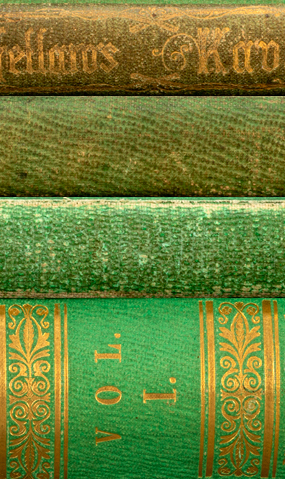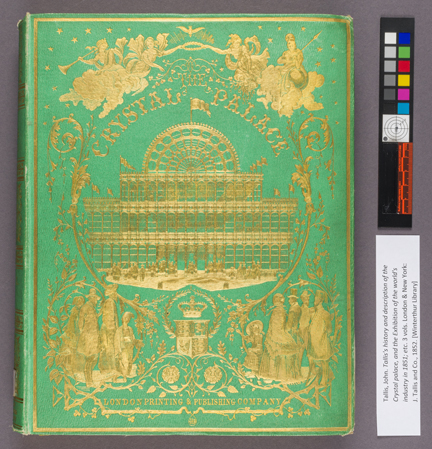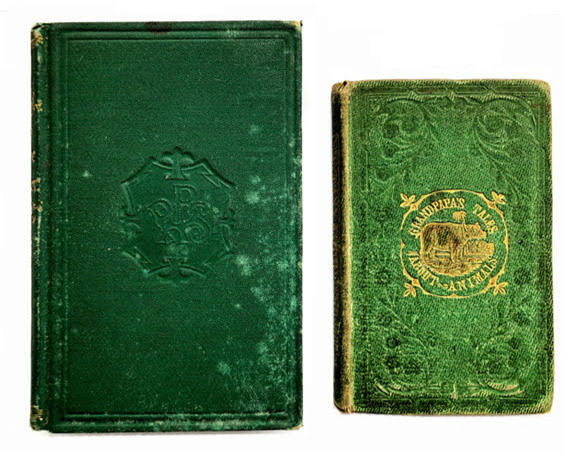Poison Book Project
The Winterthur Poison Book Project is an ongoing investigation to explore the materiality of Victorian-era publishers’ bindings, with a focus on the identification of potentially toxic pigments used as bookcloth colorants. For the most current information about the project, please monitor this wiki, which is updated regularly. Project updates are also shared on Instagram through [@winterthurconservation] using the hashtags #poisonbookproject and #bibliotoxicology.
Contents
- 1 Toxic Bookcloth Colorants
- 2 General Handling Tips for 19th-Century Cloth-Case Bindings
- 3 Emerald Green Bookcloth
- 4 Trends in Use of Emerald Green Bookcloth
- 5 Emerald Green Color Swatch Bookmark
- 6 Safe Handling & Storage Tips for Arsenical Books
- 7 Disaster Planning & Response for Arsenical Books
- 8 Arsenical Books Database
- 9 Project Researchers
- 10 Project Publications & Presentations
- 11 Further Reading
- 12 Funding Acknowledgments
- 13 Disclaimer
Toxic Bookcloth Colorants
Nearly 50% of the 19th-century, cloth-case bindings analyzed for this project to date contain lead in the bookcloth. Analysis of a range of bookcloth colors has also identified arsenic, barium, chromium, copper, iron, and mercury.
- Continue reading below for more information on books bound with arsenic-containing emerald green bookcloth.
- Visit Chrome Yellow Bookcloth for books bound with chromium-based chrome yellow bookcloth.
General Handling Tips for 19th-Century Cloth-Case Bindings
No matter which pigments or dyes may be present, it is best practice to avoid ingesting anything or touching the face while handling 19th-century, cloth-bound books. It is also best practice to wash hands after handling books, especially before eating, drinking, or smoking.
Emerald Green Bookcloth
In early 2019, analysis of 19th-century, cloth-case publishers’ bindings at Winterthur Library revealed bookcloth colored with “emerald green,” or copper acetoarsenite, an inorganic pigment known to be extremely toxic. This pigment’s popularity in England and the United States during the Victorian era is well documented. While the colorant was known to be widely used in textiles for home decoration and apparel, wallpaper, and toys, its use specifically in bookcloth had not been formally explored. Successful commercial bookcloths were a closely guarded trade secret during the nineteenth century, limiting our current understanding of their materiality and manufacture.
Conservation staff and interns at Winterthur Museum, Garden and Library conducted an initial survey of bookcloth pigments in the library’s circulating and rare book collections, later expanding their data set in cooperation with The Library Company of Philadelphia. Books published between 1837 and 1900, a time-period which aligns with the rising use of commercial bookcloth on publishers' case bindings, were analyzed with X-ray fluorescence (XRF) spectroscopy. When arsenic and copper were detected together, Raman spectroscopy was used to confirm copper acetoarsenite.
The first 200 books tested represented a range of vivid bookcloth colors. Thereafter, only books covered in green cloth were selected for analysis, in order to focus on arsenic and move through the collection more efficiently. Now that analysis of green bindings is complete, other colors of bookcloth continue to be analyzed in stages.
Nearly 350 green cloth bindings in the collections of Winterthur and The Library Company of Philadelphia were analyzed. Two books procured from second-hand booksellers were also included in the testing, and were confirmed to contain emerald green. In total, 39 green cloth bindings were found to contain arsenic. Quantitative analysis performed at the University of Delaware Soil Testing Lab indicated that emerald green bookcloth colorant is extremely friable and offsets a significantly detectable amount of arsenic. Emerald green publishers’ bindings present a health risk to librarians, booksellers, collectors, and researchers, and should be identified, handled, and stored with caution.
Trends in Use of Emerald Green Bookcloth
Based on the data collected at Winterthur Library and The Library Company of Philadelphia, the following trends in the use of emerald green bookcloth have been identified:

- Note: only English and American imprints were analyzed for the initial study
- Vibrant green bookcloth covering the boards (front and back covers)
- Vibrant green or faded brownish bookcloth on the spine
- Gold and blind stamped decoration, often paired with gilt textblock edges
- Publication date primarily between 1840s-1860s
- Variations on a morocco grain pattern are common, although other bookcloth grains have also been identified
We have developed a color swatch bookmark to aid in the visual identification of volumes potentially bound in emerald green bookcloth.
Emerald Green Color Swatch Bookmark
As of December 2021, we have mailed over 800 bookmarks to 35 of the United States and 18 countries around the world. These bookmarks are intended to assist with visual identification of bookcloth which may be pigmented with copper acetoarsenite (emerald green). Bookmark recipients are encouraged to follow up a tentative identification of emerald green bookcloth with instrumental analysis, when possible, to confirm or refute the presence of arsenic. To receive a color swatch bookmark, please email reference@winterthur.org and write “Emerald Green Bookmark” in the subject line. Please include the following information in your email:
- Name
- Mailing address
- Daytime phone number
- We will not share your contact information with third parties.
Safe Handling & Storage Tips for Arsenical Books
Avoid opportunities for ingestion or inhalation of emerald green pigment. Avoid eating, drinking, smoking, biting fingernails, or touching the face while handling potentially arsenical bookcloth.
Wear nitrile gloves:
Avoid handling suspected emerald green bookcloth with bare hands. Although arsenic is unlikely to be absorbed through the skin, it can offset onto the hands and be ingested or inhaled through touching the face or eating/drinking. Handling books with damp or sweaty hands can increase the risk of arsenic offsetting onto the skin.
Wash hands:
Even when using gloves, wash hands after handling suspected emerald green bookcloth.
Isolate book for storage:
If a book is suspected to be bound in emerald green bookcloth, seal the book in a zip-top, polyethylene baggie to limit handling and contain potentially friable pigment. Winterthur Library relocated arsenical books from its circulating collection to its rare book collection.
Wipe down surfaces:
Handle books bound in emerald green bookcloth on hard surfaces (such as a table), and avoid upholstered surfaces (such as an armchair). After handling, wipe down hard surfaces that have come into contact with the book using a damp, disposable cloth.
For Conservators:
A professional conservator performing a conservation treatment on a book bound in emerald green bookcloth should observe the same precautions as above. In addition, work under a certified chemical fume hood. If a chemical fume hood is not available, a second option is to conduct treatment using a ductless fume hood for particulates with a combination HEPA/charcoal filter. Be aware that the introduction of wet adhesives could cause arsenic to migrate in greater concentration toward the source of moisture. Contact between copper acetoarsenite and acidic substances can trigger the release of highly toxic arsine gas.
Disaster Planning & Response for Arsenical Books
Should a disaster situation arise involving fire or water, the risks associated with arsenical bookcloth increase. These risks can be mitigated with disaster planning and labeling. Consider storing arsenical books together in one storage area which can be clearly labeled for disaster responders, in addition to item-level caution labels on individual enclosures. While proper PPE should always be worn during salvage, make sure the need for PPE when handling arsenical books is emphasized in written disaster plans.
Arsenical Books Database
The Arsenical Books Database contains information about green, mass-produced, 19th-century bookbindings collected from bookmark recipients, as well as more conclusive identification of arsenic by Winterthur and other contributing institutions using instrumental analysis. To contribute data to the project, please read How To Submit Data to the Poison Book Project.
Identification Methods for Emerald Green Bookcloth
X-ray Fluorescence Spectroscopy (XRF)
Portable XRF using a zero background plate has proven efficient and accurate as the primary method for identification of emerald green bookcloth in this study. According to the data collected thus far, emerald green pigment was rarely, if ever, mixed with additional pigments when used as a bookcloth colorant. The qualitative XRF spectra consistently indicate strong peaks for copper and arsenic. We strongly recommend collecting qualitative data (counts/spectra), not quantitative data (ppm or %).
Raman Spectroscopy
When possible, Raman spectroscopy has been used to confirm copper acetoarsenite (emerald green) as the specific molecular compound present in arsenical green bookcloth. At Winterthur, eleven books found to contain copper and arsenic (with XRF) have been confirmed with Raman to contain emerald green.
Polarized Light Microscopy (PLM)
In an effort to explore additional techniques for the reliable identification of emerald green, small, destructive samples of seven green bookcloths were analyzed by polarized light microscopy. Examination in plane- and cross-polarized light conclusively and correctly identified emerald green as the colorant in three of the samples, and found a mixture of Prussian blue and chrome yellow in the other four. Tips and recommendations for sampling, sample preparation, and analysis by PLM were compiled into a document available upon request from mtedone[at]winterthur[dot]org or rgrayburn[at]winterthur[dot]org.
Microchemical Test Kits
The Winterthur research team has tested two microchemical test kits for the detection of arsenic, Millipore and Industrial Test Systems. Both accurately confirmed the presence of arsenic in emerald green bookcloth. However, these tests rely on the creation and measurement of arsine gas, arsenic’s most deadly form, and the amount of arsine gas produced when testing emerald green bookcloth proved higher than the test kit's measurement scale. The test strips also contain other toxic components such as mercury, and each test produces a significant amount (100 mL) of contaminated solvent that must be disposed of properly. Arsenic spot tests should be performed only by persons trained in chemical safety, wearing appropriate PPE, under a certified chemical fume hood, with access to safe disposal for hazardous waste according to state law. Arsenic test kits should under no circumstances be used in the home or general library environment.
Color Swatch Bookmark
The Winterthur research team has developed an emerald green color swatch bookmark that is freely available upon request (see above). The bookmark is not a conclusive means of identifying emerald green, but it can help give a visual indication that, when combined with other context clues such as publication date, may help narrow down whether a book is likely to be bound in arsenical green cloth. The color swatch bookmark offers the means to sort a book collection using visual identification, allowing institutions or private individuals to target the books of greatest concern in their collections and make the most efficient and cost-effective use of a consultant to perform instrumental analysis. For institutions or individuals who cannot afford to contract for follow-up instrumental analysis, the bookmark at least provides some means, albeit imperfect, of estimating risk.
Project Researchers
Lead Conservator: Dr. Melissa Tedone
Lead Scientist: Dr. Rosie Grayburn
Winterthur Team:
- Meghan Abercrombie, Winterthur Intern
- Philip DePaola, Winterthur Intern
- Dr. Patricia Elena Gonzales Gil, Visiting Researcher (Winterthur), Professor, Sección Química, Pontificia Universidad Católica del Perú
- Emily Guthrie, (former) Winterthur Library Director, and Winterthur Library staff
- Layla Huff, Winterthur Intern
- Sara Leonowitz, Winterthur Intern
- Jess Ortegon, WUDPAC Fellow
- Mina Porell, Winterthur Postgraduate Fellow in Paintings Conservation
- Esther Weyer, Winterthur Intern
The Library Company of Philadelphia
- Jennifer Rosner, (former) Head of Conservation
Bookmark Designer:
- Karissa Muratore, WUDPAC ('20)
Consultants:
- Michael Gladle, (former) Director, University of Delaware Environmental Health & Safety
- Karen Gartley, Research Manager/Program Director, University of Delaware Soil Testing Program
Analytical Data Contributors:
- Kirsten Moffitt, Conservator and Materials Analyst, Colonial Williamsburg Foundation
Project Publications & Presentations
Publications
Tedone, Melissa, and Rosie Grayburn. Forthcoming. "Arsenic and Old Bookcloth: Identification and Safer Use of Emerald Green Victorian-Era Cloth Case Bindings." Journal of the American Institute for Conservation. Accepted October 26, 2021.
Tedone, Melissa, and Rosie Grayburn. "Arsenic and Old Bookcloth: The Safe Handling, Treatment, and Storage of Victorian-Era Cloth Case Bindings." Book and Paper Group Annual 39 (2020).
Tedone, Melissa. "Poison Book Project". IIC News in Conservation 77. April-May, 2020. 10-13.
Presentations (click links to access recordings)
Tedone, Melissa. "The Poison Book Project: Arsenic in Victorian-Era, Mass-Produced Bookbindings". Friends of the University of Delaware Library Fall Faculty Lecture. November 16, 2021.
Tedone, Melissa and Rosie Grayburn. "It Ain't Easy Being Green: The Poison Book Project". The Grolier Club. May 11, 2021.
Tedone, Melissa. Toxic Tomes in Context: 19th-century Decorated Cloth Bindings. Objects Up Close series (virtual). Winterthur Museum, Garden & Library. March 16, 2021.
Tedone, Melissa. "Toxic Tomes: A Hidden Hazard in the Victorian Home." Pre-recorded lecture. Virtual Delaware Antiques Show Lecture Series. November 7-14, 2020.
Tedone, Melissa. Arsenic and Old Bookcloth: A Hidden Hazard in Victorian-Era Books. Presentation for Winterthur Collector's Circle Virtual Salon Series. September 2, 2020.
Tedone, Melissa, and Rosie Grayburn. Arsenic and Old Bookcloth: The Safe Handling, Treatment, and Storage of Victorian-Era Cloth Case Bindings. American Institute for Conservation 48th Annual Meeting. June 30, 2020.
Tedone, Melissa, and Rosie Grayburn. Winterthur Poison Book Project. Presented virtually at the ICON Book and Paper Annual General Meeting. June 3, 2020.
Tedone, Melissa, and Rosie Grayburn. Poison Book Project: Analyzing Toxic Pigments in Victorian-Era Bookcloth. Lightning-round presentation at Safety and Cultural Heritage Summit, Smithsonian American Art Museum, Washington DC. October 30, 2019.
Further Reading
"Copper Acetoarsenite." NOAA CAMEO Chemicals version 2.7.1. rev 1. Accessed February 13,2020. https://cameochemicals.noaa.gov/chemical/2981
Gehle, Kim. “Arsenic Toxicity.” Environmental Health and Medicine. Centers for Disease Control and Prevention, Agency for Toxic Substances & Disease Registry, last modified January 15, 2010. https://www.atsdr.cdc.gov/csem/csem.asp?csem=1&po=0
Lundblad, Kristina. 2015. Bound to be modern : publishers' cloth bindings and the material culture of the book, 1840-1914. Trans. Alan Crozier. New Castle, DE : Oak Knoll Press.
Krupp, Andrea. 2008. Bookcloth in England and America, 1823-50. New Castle, DE: Oak Knoll Press; London: British Library; New York: Bibliographical Society of America.
Tomlinson, William, and Richard Masters. 1996. Bookcloth 1823-1980 : a study of early use and the rise of manufacture, Winterbottom's dominance of the trade in Britain and America, production methods and costs, and the identification of qualities and designs. Cheshire, Eng.: D. Tomlinson.
Whorton, James C. 2010. The Arsenic Century: how Victorian Britain was poisoned at home, work, and play. Oxford, New York: Oxford University Press.
Funding Acknowledgments
The project team gratefully acknowledges the following support for the Poison Book Project:
- The University of Delaware Art Conservation Department for generously funding the design and first printing of our color swatch bookmark.
- Our many generous donors who supported the project during the Do More 24 Delaware fundraising campaign coordinated by the United Way in February, 2020.
- The ICON Fred Bearman Research Grant to support archival research into bookcloth manufacture and use in England.
Disclaimer
Copyright 2024. This article describes conservation procedures and is meant to be used as exchange of technical information among trained cultural heritage conservators, and the procedures described herein should not be performed by anyone who is not a trained professional. Further, any advice, graphics, images, and information contained in this page is presented for general educational and information purposes, and to increase safety awareness in connection with the storage and handling of aged books that may contain toxic chemicals, such as arsenic. The storage, handling, and other safety tips included in this page are suggestions only and have been collected by the Poison Book Project of The Henry Francis du Pont Winterthur Museum, Inc. after consultation with scientists and other experts in the conservation field. None of the content in this page has been subjected to a formal peer review and is not intended to be medical or other expert advice or services, and should not be used in place of consultation with appropriate professionals. The information contained in this page should not be considered exhaustive, and the user should seek the advice of appropriate professionals.
In no event shall The Henry Francis du Pont Winterthur Museum, Inc. or its trustees, officers, affiliates, and employees, be liable for any liability, loss, injury, or risk (including, without limitation, incidental and consequential damages, personal injury/wrongful death, lost profits, or damages) which is incurred or suffered as a direct or indirect result of the use of any of the material, advice, guidance, or services on this site, whether based on warranty, contract, tort, or any other legal theory and whether or not The Henry Francis du Pont Winterthur Museum, Inc. or any of its trustees, officers, or employees is advised of the possibility of such damages. THE HENRY FRANCIS DU PONT WINTERTHUR MUSEUM, INC., TO THE FULLEST EXTENT PERMITTED BY LAW, DISCLAIMS ALL WARRANTIES, EITHER EXPRESS OR IMPLIED, STATUTORY OR OTHERWISE, INCLUDING BUT NOT LIMITED TO THE IMPLIED WARRANTIES OF MERCHANTABILITY, NON-INFRINGEMENT OF THIRD PARTIES’ RIGHTS, AND FITNESS FOR PARTICULAR PURPOSE.

